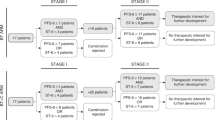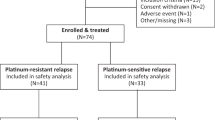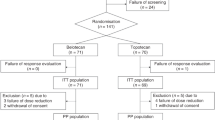Abstract
Weekly paclitaxel is a highly active and well tolerated regimen that is increasingly being adopted for the treatment of relapsed ovarian cancer. This regimen is usually administered at 80–90 mg/m2/week, and the use of a 1 h infusion helps minimize myelosuppression. When compared with the 3-weekly schedule, weekly paclitaxel is better tolerated, with a reduced frequency of grade 3–4 toxic effects. Single-agent weekly paclitaxel for relapsed ovarian cancer yields response rates in the range of 20–62%; however, response duration can be short. Responses to weekly paclitaxel have been observed in patients whose tumors are resistant to 3-weekly paclitaxel. The level of activity of weekly paclitaxel for relapsed disease has led to its detailed evaluation in the first-line setting, and interest has been enhanced by the results of a Japanese Gynecological Oncology Group study that demonstrated a survival advantage for weekly paclitaxel compared with 3-weekly paclitaxel in combination with carboplatin as initial treatment. The enhanced efficacy of weekly paclitaxel may be due to greater drug exposure, a direct antiangiogenic effect, or both. Current research topics include the combination of weekly paclitaxel with molecular-targeted agents and the use of molecular profiling to better select patients for treatment.
Key Points
-
Weekly paclitaxel is usually administered at 80–90 mg/m2/week, making use of a 1 h infusion to help minimize myelosuppression
-
Patients with relapsed ovarian cancer are increasingly being treated with weekly paclitaxel as a result of the high response rates seen with this well-tolerated regimen
-
Weekly paclitaxel is generally better tolerated than 3-weekly paclitaxel, with a reduced risk of grade 3–4 toxic effects
-
Responses to weekly paclitaxel have been observed in patients who have developed progressive disease within 6 months of prior taxane therapy
-
The enhanced efficacy of weekly paclitaxel may be due to greater drug exposure, a direct antiangiogenic effect, or both
-
Studies are assessing the combination of weekly paclitaxel with molecular-targeted agents and the use of molecular profiling to better select patients for treatment
This is a preview of subscription content, access via your institution
Access options
Subscribe to this journal
Receive 12 print issues and online access
$209.00 per year
only $17.42 per issue
Buy this article
- Purchase on Springer Link
- Instant access to full article PDF
Prices may be subject to local taxes which are calculated during checkout
Similar content being viewed by others
References
Cannistra, S. A. Cancer of the ovary. N. Engl. J. Med. 351, 2519–2529 (2004).
Covens, A. et al. Systematic review of first-line chemotherapy for newly diagnosed postoperative patients with stage II, III, or IV epithelial ovarian cancer. Gynecol. Oncol. 85, 71–80 (2002).
McGuire, W. P. et al. Cyclophosphamide and cisplatin compared with paclitaxel and cisplatin in patients with stage III and stage IV ovarian cancer. N. Engl. J. Med. 334, 1–6 (1996).
Piccart, M. J. et al. Randomized intergroup trial of cisplatin-paclitaxel versus cisplatin-cyclophosphamide in women with advanced epithelial ovarian cancer: three-year results. J. Natl Cancer Inst. 92, 699–708 (2000).
Ozols, R. F. et al. Phase III trial of carboplatin and paclitaxel compared with cisplatin and paclitaxel in patients with optimally resected stage III ovarian cancer: a Gynecologic Oncology Group study. J. Clin. Oncol. 21, 3194–3200 (2003).
Katsumata, N. et al. Dose-dense paclitaxel once a week in combination with carboplatin every 3 weeks for advanced ovarian cancer: a phase 3, open-label, randomised controlled trial. Lancet 374, 1331–1338 (2009).
Marchetti, P. et al. Weekly administration of paclitaxel: theoretical and clinical basis. Crit. Rev. Oncol. Hematol. 44 (Suppl.), S3–S13 (2002).
Jordan, M. A. & Wilson, L. Microtubules as a target for anticancer drugs. Nat. Rev. Cancer 4, 253–265 (2004).
Schwartz, E. L. Antivascular actions of microtubule-binding drugs. Clin. Cancer Res. 15, 2594–2601 (2009).
Belotti, D. et al. The microtubule-affecting drug paclitaxel has antiangiogenic activity. Clin. Cancer Res. 2, 1843–1849 (1996).
Grant, D. S. et al. Comparison of antiangiogenic activities using paclitaxel (taxol) and docetaxel (taxotere). Int. J. Cancer 104, 121–129 (2003).
Pasquier, E. et al. Antiangiogenic activity of paclitaxel is associated with its cytostatic effect, mediated by the initiation but not completion of a mitochondrial apoptotic signaling pathway. Mol. Cancer Ther. 3, 1301–1310 (2004).
Pasquier, E. et al. Antiangiogenic concentrations of paclitaxel induce an increase in microtubule dynamics in endothelial cells but not in cancer cells. Cancer Res. 65, 2433–2440 (2005).
Simon, R. & Norton, L. The Norton–Simon hypothesis: designing more effective and less toxic chemotherapeutic regimens. Nat. Clin. Pract. Oncol. 3, 406–407 (2006).
Gianni, L. et al. Nonlinear pharmacokinetics and metabolism of paclitaxel and its pharmacokinetic/pharmacodynamic relationships in humans. J. Clin. Oncol. 13, 180–190 (1995).
Kerbel, R. S. & Kamen, B. A. The anti-angiogenic basis of metronomic chemotherapy. Nat. Rev. Cancer 4, 423–436 (2004).
Thomas, H. & Rosenberg, P. Role of weekly paclitaxel in the treatment of advanced ovarian cancer. Crit. Rev. Oncol. Hematol. 44 (Suppl.), S43–S51 (2002).
Klaassen, U. et al. Phase I study with a weekly 1 h infusion of paclitaxel in heavily pretreated patients with metastatic breast and ovarian cancer. Eur. J. Cancer 32A, 547–549 (1996).
Löffler, T. M. et al. Schedule- and dose-intensified paclitaxel as weekly 1-hour infusion in pretreated solid tumors: results of a phase I/II trial. Semin. Oncol. 23, 32–34 (1996).
Abu-Rustum, N. R. et al. Salvage weekly paclitaxel in recurrent ovarian cancer. Semin. Oncol. 24, S15-62–S15-67 (1997).
Andersson, H., Horvath, G. & Mellqvist, L. Taxol given weekly in advanced previously treated ovarian carcinomas – a pilot study. Int. J. Gynecol. Cancer 7, 262–266 (1997).
Fennelly, D. et al. Phase I and pharmacologic study of paclitaxel administered weekly in patients with relapsed ovarian cancer. J. Clin. Oncol. 15, 187–192 (1997).
Takano, M. et al. Phase I and pharmacological study of single paclitaxel administered weekly for heavily pre-treated patients with epithelial ovarian cancer. Anticancer Res. 22, 1833–1838 (2002).
Breier, S. et al. Phase I/II weekly paclitaxel (P) 80 mg/m2 in pretreated patients (pts) with breast (BC) and ovarian cancer (OC) [abstract]. Proc. Am. Soc. Clin. Oncol. 16, a568 (1997).
Kaern, J., Baekelandt, M. & Tropé, C. G. A phase II study of weekly paclitaxel in platinum and paclitaxel-resistant ovarian cancer patients. Eur. J. Gynaecol. Oncol. 23, 383–389 (2002).
Markman, M. et al. Phase II trial of weekly single-agent paclitaxel in platinum/paclitaxel-refractory ovarian cancer. J. Clin. Oncol. 20, 2365–2369 (2002).
Ota, S. et al. Weekly 1 hour paclitaxel infusion in patients with recurrent gynecological tumors: a pilot study. Jpn J. Clin. Oncol. 31, 395–398 (2001).
Thirapakawong, C., Senapad, S. & Padungsutt, P. Phase II study of weekly paclitaxel (Taxol) as a second line chemotherapy in refractory epithelial ovarian cancer (EOC): a multicenter study [abstract]. Proc. Am. Soc. Clin. Oncol. 20, a2506 (2001).
Kita, T. et al. The effect of single weekly paclitaxel in heavily pretreated patients with recurrent or persistent advanced ovarian cancer. Gynecol. Oncol. 92, 813–818 (2004).
Ghamande, S. et al. Weekly paclitaxel in patients with recurrent or persistent advanced ovarian cancer. Int. J. Gynecol. Cancer 13, 142–147 (2003).
Dunder, I. et al. Preliminary experience with salvage weekly paclitaxel in women with advanced recurrent ovarian carcinoma. Eur. J. Gynaecol. Oncol. 26, 79–82 (2005).
Gladieff, L., Lortholary, A. & Largillier, R. Weekly paclitaxel (wP) as single agent or in combination with weekly topotecan (wT) or carboplatin (C) in patients with resistant ovarian cancer (ROC): the phase II CARTAXHY randomized trial from GINECO [abstract]. J. Clin. Oncol. 27, a5557 (2009).
Gynecologic Oncology Group et al. Phase II trial of weekly paclitaxel (80 mg/m2) in platinum and paclitaxel-resistant ovarian and primary peritoneal cancers: a Gynecologic Oncology Group study. Gynecol. Oncol. 101, 436–440 (2006).
Rosenberg, P. et al. Randomized trial of single agent paclitaxel given weekly versus every three weeks and with peroral versus intravenous steroid premedication to patients with ovarian cancer previously treated with platinum. Acta Oncol. 41, 418–424 (2002).
Creemers, G. J. et al. Topotecan, an active drug in the second-line treatment of epithelial ovarian cancer: results of a large European phase II study. J. Clin. Oncol. 14, 3056–3061 (1996).
Markman, M. et al. Tamoxifen in platinum-refractory ovarian cancer: a Gynecologic Oncology Group Ancillary Report. Gynecol. Oncol. 62, 4–6 (1996).
Muggia, F. M. et al. Phase II study of liposomal doxorubicin in refractory ovarian cancer: antitumor activity and toxicity modification by liposomal encapsulation. J. Clin. Oncol. 15, 987–993 (1997).
Rose, P. G. et al. Prolonged oral etoposide as second-line therapy for platinum-resistant and platinum-sensitive ovarian carcinoma: a Gynecologic Oncology Group study. J. Clin. Oncol. 16, 405–410 (1998).
Shapiro, J. D. et al. Activity of gemcitabine in patients with advanced ovarian cancer: responses seen following platinum and paclitaxel. Gynecol. Oncol. 63, 89–93 (1996).
Baird, R. D. et al. Weekly paclitaxel in the treatment of relapsed ovarian and primary peritoneal cancer—Royal Marsden Hospital experience (2003–2008) [abstract]. Eur. J. Cancer Supplements 7, aP–8052 (2009).
Griffiths, R. et al. Effectiveness of multiple lines of chemotherapy in platinum-resistant ovarian cancer: the Christie experience [abstract]. Eur. J. Cancer Supplements 7, aO-8004 (2009).
Linch, M. et al. Experience in a UK cancer centre of weekly paclitaxel in the treatment of relapsed ovarian and primary peritoneal cancer. Gynecol. Oncol. 109, 27–32 (2008).
Boruta, D. M. et al. Weekly paclitaxel infusion as salvage therapy in ovarian cancer. Cancer Invest. 21, 675–681 (2003).
Rose, P. G., Smrekar, M. & Fusco, N. A phase II trial of weekly paclitaxel and every 3 weeks of carboplatin in potentially platinum-sensitive ovarian and peritoneal carcinoma. Gynecol. Oncol. 96, 296–300 (2005).
Sehouli, J. et al. Weekly paclitaxel and carboplatin (PC-W) for patients with primary advanced ovarian cancer: results of a multicenter phase-II study of the NOGGO. Cancer Chemother. Pharmacol. 61, 243–250 (2008).
Katsumata, N. A phase II trial of weekly paclitaxel/carboplatin (TJ) as salvage chemotherapy in patients with relapsed ovarian cancer [abstract]. Proc. Am. Soc. Clin. Oncol. 20, a865 (2001).
van der Burg, M. E. et al. What is the role of dose-dense therapy? Int. J. Gynecol. Cancer 15 (Suppl. 3), 233–240 (2005).
Sharma, R. et al. Extended weekly dose-dense paclitaxel/carboplatin is feasible and active in heavily pre-treated platinum-resistant recurrent ovarian cancer. Br. J. Cancer 100, 707–712 (2009).
Cadron, I. et al. The “Leuven” dose-dense paclitaxel/carboplatin regimen in patients with recurrent ovarian cancer. Gynecol. Oncol. 106, 354–361 (2007).
Gore, M. E. et al. Treatment of relapsed carcinoma of the ovary with cisplatin or carboplatin following initial treatment with these compounds. Gynecol. Oncol 36, 207–211 (1990).
Swanton, C. et al. Regulators of mitotic arrest and ceramide metabolism are determinants of sensitivity to paclitaxel and other chemotherapeutic drugs. Cancer Cell 11, 498–512 (2007).
Juul, N. et al. Assessment of an RNA interference screen-derived mitotic and ceramide pathway metagene as a predictor of response to neoadjuvant paclitaxel for primary triple-negative breast cancer: a retrospective analysis of five clinical trials. Lancet Oncol. 11, 358–365 (2010).
Swanton, C. et al. Chromosomal instability determines taxane response. Proc. Natl Acad. Sci. USA 106, 8671–8676 (2009).
Dressman, H. K. et al. An integrated genomic-based approach to individualized treatment of patients with advanced-stage ovarian cancer. J. Clin. Oncol. 25, 517–525 (2007).
Lee, J. K. et al. Prospective comparison of clinical and genomic multivariate predictors of response to neoadjuvant chemotherapy in breast cancer. Clin. Cancer Res. 16, 711–718 (2010).
Coleman, R. et al. A phase II evaluation of nab-paclitaxel in the treatment of recurrent or persistent platinum-resistant ovarian, fallopian tube, or primary peritoneal cancer: A Gynecologic Oncology Group (GOG) study [abstract]. J. Clin. Oncol. 28, a5010 (2010).
Davis, M. et al. Nanoparticle therapeutics: an emerging treatment modality for cancer. Nat. Rev. Drug Discov. 7, 771–782 (2008).
Kavallaris, M. Microtubules and resistance to tubulin-binding agents. Nat. Rev. Cancer 10, 194–204 (2010).
US National Library of Medicine. ClinicalTrials.gov [online], (2010).
US National Library of Medicine. ClinicalTrials.gov [online], (2010).
US National Library of Medicine. ClinicalTrials.gov [online], (2010).
US National Library of Medicine. ClinicalTrials.gov [online], (2010).
Cancer Research UK & UCL Cancer Trials Centre. http://www.ctc.ucl.ac.uk [online], (2010).
US National Library of Medicine. ClinicalTrials.gov [online], (2010).
Acknowledgements
The Drug Development Unit of the Royal Marsden National Health Service Foundation Trust and The Institute of Cancer Research is supported in part by a program grant from Cancer Research UK. Support was also provided by the Experimental Cancer Medicine Center (to The Institute of Cancer Research) and the National Institute for Health Research Biomedical Research Center (jointly to the Royal Marsden National Health Service Foundation Trust and The Institute of Cancer Research).
Author information
Authors and Affiliations
Contributions
R. D. Baird and D. S. P. Tan are joint first authors of this manuscript. All authors contributed to the research of data, discussion of content, writing and editing of this Review.
Corresponding author
Ethics declarations
Competing interests
The authors declare no competing financial interests.
Rights and permissions
About this article
Cite this article
Baird, R., Tan, D. & Kaye, S. Weekly paclitaxel in the treatment of recurrent ovarian cancer. Nat Rev Clin Oncol 7, 575–582 (2010). https://doi.org/10.1038/nrclinonc.2010.120
Published:
Issue Date:
DOI: https://doi.org/10.1038/nrclinonc.2010.120
This article is cited by
-
The effect of paclitaxel- and fisetin-loaded PBM nanoparticles on apoptosis and reversal of drug resistance gene ABCG2 in ovarian cancer
Journal of Ovarian Research (2023)
-
Hierarchical network analysis of co-occurring bioentities in literature
Scientific Reports (2022)
-
Phase I study of lurbinectedin in combination with weekly paclitaxel with or without bevacizumab in patients with advanced solid tumors
Investigational New Drugs (2022)
-
Schultriene and nigtetraene: two sesterterpenes characterized from pathogenetic fungi via genome mining approach
Applied Microbiology and Biotechnology (2022)
-
Exposure to low intensity ultrasound removes paclitaxel cytotoxicity in breast and ovarian cancer cells
BMC Cancer (2021)



